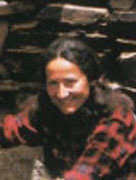This is an old revision of this page, as edited by 2601:603:1b7f:d23b:a8fa:8cbc:8c4:3658 (talk) at 07:01, 3 August 2019 (Capitalized the 'M' in mountaineer for occupation.). The present address (URL) is a permanent link to this revision, which may differ significantly from the current revision.
Revision as of 07:01, 3 August 2019 by 2601:603:1b7f:d23b:a8fa:8cbc:8c4:3658 (talk) (Capitalized the 'M' in mountaineer for occupation.)(diff) ← Previous revision | Latest revision (diff) | Newer revision → (diff)| Hannelore Schmatz | |
|---|---|
| Hannelore Schmatz | |
 Hannelore Schmatz Hannelore Schmatz | |
| Born | (1940-02-16)16 February 1940 Regensburg |
| Died | 2 October 1979(1979-10-02) (aged 39) Mount Everest |
| Cause of death | Cold, exhaustion |
| Nationality | |
| Occupation | Mountaineer |
| Spouse | Gerhard Schmatz |
Hannelore Schmatz (16 February 1940 – 2 October 1979) was a German mountaineer. She collapsed and died as she was returning from summiting Mount Everest via the southern route, the first woman and first German citizen to die on the upper slopes of Everest.
Biography
Schmatz was on an expedition via the South East Ridge route with her husband when she died at 8,300 metres (27,200 ft). Gerhard Schmatz was the expedition leader, 50 years of age at the time and the oldest man to summit Everest. On the same expedition was the American Ray Genet, who also died while descending from the summit. Exhausted from the climb, they had stopped to bivouac as the night approached, despite the fact that their Sherpa guides had urged them not to. Ray Genet died later that night and both the Sherpa and Schmatz were distressed, but decided to continue their descent. At the height of 8,300m Schmatz sat down and said "Water, Water" to her Sherpa and died. Sungdare Sherpa, one of the Sherpa guides, remained with her body, and as a result, lost most of his fingers and toes.
Genet's body ultimately disappeared under the snow, but Schmatz's body was swept further down the mountain.
For years, Schmatz's remains could be seen by anyone attempting to summit Everest by the southern route. Her body was frozen in a sitting position, leaning against her backpack with eyes open and hair blowing in the wind, about 100 metres above Camp IV.
In 1984, police inspector Yogendra Bahadur Thapa and Sherpa Ang Dorje fell to their deaths while trying to recover Schmatz’s body on a Nepalese police expedition.
Chris Bonington spotted Schmatz from a distance in 1985, and initially mistook her body for a tent until he got a closer look.
Lene Gammelgaard, the first Scandinavian woman to reach the peak of Everest, quotes the Norwegian mountaineer and expedition leader Arne Næss, Jr. describing his encounter with Schmatz's remains, in her book Climbing High: A Woman's Account of Surviving the Everest Tragedy (1999), which recounts her own 1996 expedition. Næss' description is as follows:
"It's not far now. I can't escape the sinister guard. Approximately 100 meters above Camp IV she sits leaning against her pack, as if taking a short break. A woman with her eyes wide open and her hair waving in each gust of wind. It's the corpse of Hannelore Schmatz, the wife of the leader of a 1979 German expedition. She summited, but died descending. Yet it feels as if she follows me with her eyes as I pass by. Her presence reminds me that we are here on the conditions of the mountain."
The wind eventually blew Schmatz's remains over the edge and down Kangshung Face.
See also
References
-
"Everest summiter Hannelore Schmatz". Everest News. Retrieved 2008-04-08.
{{cite web}}: Cite has empty unknown parameter:|coauthors=(help) - "Dr. Gerhard Schmatz - Mt. Everest - höchster Berg der Erde". Schmatz-online.com. Retrieved 16 February 2019.
- "Archived copy" (PDF). Archived from the original (PDF) on 2012-03-09. Retrieved 2012-05-26.
{{cite web}}: Unknown parameter|dead-url=ignored (|url-status=suggested) (help)CS1 maint: archived copy as title (link) - ^ Joe Simpson (1997). Dark shadows falling. The Mountaineers Books. pp. 119–. ISBN 978-0-89886-549-3. Retrieved 7 April 2013.
-
Gammelgaard, Lene. "Climbing High: A Woman's Account of Surviving the Everest Tragedy". The New York Times. Retrieved 2008-04-08.
{{cite news}}: Cite has empty unknown parameter:|coauthors=(help) -
Salkeld, Audrey (1996-05-09). "Report from Base Camp". PBS. Retrieved 2008-04-08.
{{cite web}}: Cite has empty unknown parameter:|coauthors=(help) -
"2 Nepalese Mountaineers Die Looking for Body on Everest". The New York Times. 1984-10-29. Retrieved 2008-04-08.
{{cite web}}: Cite has empty unknown parameter:|coauthors=(help) - Gammelgaard, Lene (1999). Climbing High: A Woman's Account of Surviving the Everest Tragedy.
{{cite book}}:|website=ignored (help) - David Breashears (1 May 1999). High exposure: an enduring passion for Everest and unforgiving places. Simon & Schuster. ISBN 978-0-684-85361-1. Retrieved 7 April 2013.